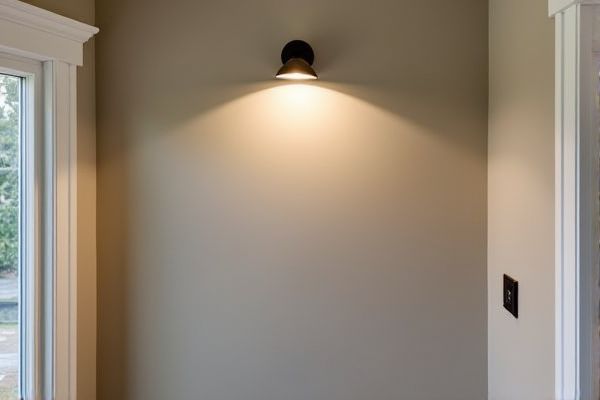
Mudroom motion sensor lights enhance convenience and energy efficiency by automatically illuminating the space when you enter, eliminating the need to fumble for switches and saving on electricity costs. Discover how choosing between motion sensor and manual lighting can transform Your daily routine by reading the rest of this article.
Table of Comparison
| Feature | Mudroom Motion Sensor Lights | Manual Mudroom Lights |
|---|---|---|
| Activation | Automatically triggers with motion detection | Requires physical switch to turn on/off |
| Energy Efficiency | Reduces energy use by auto-shutdown | Depends on user to turn off, may waste energy |
| Convenience | Hands-free operation, ideal for carrying items | Manual control, less convenient when hands are full |
| Cost | Typically higher upfront cost | Generally lower initial cost |
| Installation | May require wiring or battery setup | Simple wiring, common standard fixtures |
| Reliability | Can have sensor issues or false triggers | Consistent operation, no sensor dependency |
| Customization | Adjustable sensor sensitivity and timer settings | Full manual control over lighting duration |
Introduction to Mudroom Lighting Options
Mudroom lighting options include motion sensor lights and manual switch lights, each offering distinct advantages for functionality and convenience. Motion sensor lights automatically activate upon detecting movement, enhancing energy efficiency and hands-free operation, ideal for busy entryways. Manual lights provide consistent control over brightness and timing, preferred for precise lighting preferences and situations requiring constant illumination.
Understanding Motion Sensor Lights
Motion sensor lights in a mudroom use infrared or ultrasonic sensors to detect movement, automatically illuminating the space when someone enters, which enhances convenience and energy efficiency. Unlike manual lights that require physically flipping a switch, motion sensor lights reduce the risk of leaving lights on unintentionally, thereby lowering electricity consumption. These smart lighting options improve safety by providing immediate visibility in transitional spaces like mudrooms, especially during nighttime or when hands are full.
Manual Lights: Key Features and Functions
Manual mudroom lights offer precise control, allowing you to turn the lights on or off exactly when needed, which helps save energy by avoiding unnecessary usage. These lights typically feature standard switches and can be paired with dimmers or timers for customized lighting preferences. Your mudroom benefits from consistent illumination without the risk of sensor malfunctions or delays commonly associated with motion sensor systems.
Energy Efficiency Comparison
Mudroom motion sensor lights offer superior energy efficiency compared to manual lights by activating only when movement is detected, significantly reducing unnecessary electricity use. Manual lights often remain on longer than needed due to forgetfulness or inconvenience, leading to higher energy consumption. Installing motion sensor lights can optimize your energy usage, lowering utility bills while maintaining convenient lighting in your mudroom.
Convenience and Ease of Use
Mudroom motion sensor lights offer unparalleled convenience by automatically illuminating the space upon detecting movement, eliminating the need to fumble for switches when carrying items or entering with hands full. Manual lights require intentional activation, which can be less practical in high-traffic or cluttered mudroom environments. Motion sensor lighting enhances ease of use, providing hands-free operation that ensures safety and efficiency during busy comings and goings.
Safety and Security Considerations
Mudroom motion sensor lights enhance safety by automatically illuminating the space when movement is detected, reducing the risk of trips and falls in low-light conditions. These lights also improve security by deterring potential intruders through unexpected brightness, signaling occupancy. Manual lights require user activation, which can result in delayed illumination and increased vulnerability in emergency situations.
Installation and Maintenance Differences
Mudroom motion sensor lights require a more complex installation process involving wiring and sensor calibration, while manual lights typically need straightforward wiring or battery installation. Maintenance for motion sensor lights includes periodic sensor cleaning and occasional sensitivity adjustments, whereas manual lights primarily require regular bulb replacement or battery changes. The automation in motion sensor lights reduces frequent manual interaction, providing convenience but necessitating occasional technical upkeep.
Cost Analysis: Upfront and Long-Term
Mudroom motion sensor lights typically have a higher upfront cost due to advanced sensors and installation complexity but offer long-term savings by reducing electricity usage and extending bulb lifespan through automation. Manual lights have a lower initial purchase price and simpler installation, yet they may incur higher energy costs over time because they rely on user operation and risk being left on unnecessarily. Evaluating total cost of ownership, motion sensor lights provide better value in high-traffic mudrooms by optimizing energy efficiency and minimizing maintenance expenses.
Aesthetic and Design Impact
Mudroom motion sensor lights enhance the aesthetic by providing seamless, hands-free illumination that blends into modern, minimalist designs without visible switches. Manual lights, while offering traditional control, often require bulky fixtures or wall switches that can disrupt clean design lines and clutter the space. Motion sensor lighting creates an unobtrusive, sleek ambiance that aligns with contemporary mudroom aesthetics, maximizing both function and style.
Choosing the Best Lighting Solution for Your Mudroom
Mudroom motion sensor lights offer hands-free convenience and energy efficiency by automatically activating when movement is detected, making them ideal for busy households. Manual lights provide reliable control and often lower upfront costs, but require physical interaction, which can be inconvenient when carrying items. Evaluating your mudroom's traffic patterns and user preferences helps determine whether sensor-activated or manual lighting best meets your functional and energy-saving needs.
 homyna.com
homyna.com